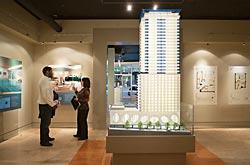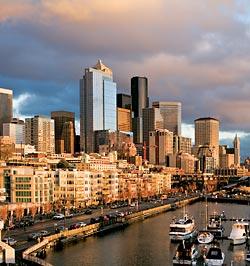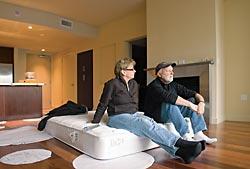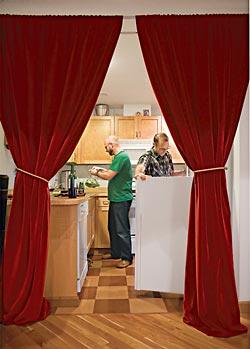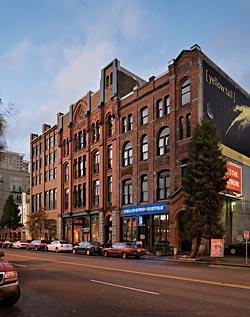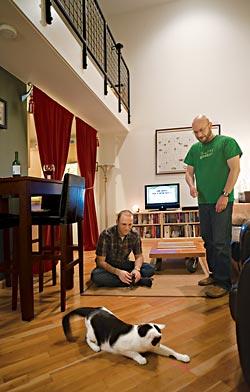Uptown Downtown

In the virtual movie, the camera closes in on a sleek, modern high-rise tower in the center of the downtown financial district, its gleaming profile encased in textured metal and clear glass.
Drenched in daylight. Words flash on the screen, cued to smooth jazz.
EXCLUSIVE garden terrace. A LUSH NEW plaza.
The tempo picks up as the camera glides to a flowing water channel that hugs the side of a building while virtual businesspeople mill about on virtual sidewalks.
At last, the doors to 5th and Madison slide open, revealing the epitome of downtown luxury-condominium living: a well-appointed concierge.
WELCOME home, the screen reads, which begs the question:
Welcome home to whom?
Fifth and Madison is just one among dozens of luxury-condominium towers bursting out of the ground at a pace rivaled only by the office-tower boom of the 1980s when some of the city's tallest buildings — the 76-story Columbia Tower among them — changed the face of downtown.
Since 2004, the number of residential developments either built, under construction or filed with the city of Seattle for permitting or design review stood at 30 in the fall. If completed, these projects would add more than 6,700 residential units to downtown by 2010, more than double the residential space available the decade before.
None of it comes cheap, unless it's of the Moda Condominium variety. Buyers there devoured the lot of $150,000, 300-square-foot Belltown pads, and their slightly larger iterations, in less than a week. To be sure, that still averages out to $500 per square foot. (They could have picked up a new townhome near Green Lake for half that.)
Prices only climb from there. At Olive 8, a 685-square-foot, one-bedroom unit went for roughly $650,000 in the fall. After the residential tower added three floors to accommodate demand, the few remaining parking spaces went for $75,000 apiece.
At Fifteen Twenty-One Second Avenue, where the average condo is 1,900 square feet, the entry-level price is $1 million. Meanwhile, the condo-hotel development Four Seasons features prices that far exceed the going rate on Manhattan's Upper West Side, at more than $2,100 per square foot.
Gary Abrahams, a 43-year-old land-use consultant who recently purchased his second condo downtown, said the prices are worth it. "I think this is the future. I think more and more people are going to want to live in downtown condos and will eschew single-family residential living."
Is Abrahams right? If he is, who can afford the move?
AT CRISTALLA, the first true luxury high-rise in more than a decade, you can still find remnants of its former glory as the Crystal Pool, or Natatorium, at the corner of Second Avenue and Lenora Street.
Built by the Stimson timber family in 1914, the pool was once filled with heated saltwater retrieved from Elliott Bay. Today, a penthouse here goes for a lip-puckering $2.65 million. That buys travertine floors, two dishwashers (the smaller one presumably for entertaining) and doors carved from black walnut burl.
Building amenities include temperature-controlled wine lockers, a full-time concierge (the kind who scores tickets to a sold-out symphony) and a rooftop garden where pets can do their business while the owner takes in the city's (other) stunning views.
Consider this emblematic of the new downtown, where granite countertops, European cabinetry and stainless-steel appliances debut in most standard packages. "The buyer today knows appliances; they know finishes," says interior designer Debbie Roskopf. "They're just so much more sophisticated."
Tamera Nyhus, 42, purchased her first downtown condo a decade ago when developers created the Waterfront Landing on the lip of Elliott Bay.
The Alaska Airlines flight attendant was helping her boyfriend shop for a condo when she decided to buy a newer one herself. In late October, Nyhus signed a purchase-and-sale agreement on a larger, one-bedroom condo at Olive 8, a 231-unit development that sits astride a Hyatt hotel.
Nyhus doesn't consider downtown condo living the ideal, but it's ideal for her. During a typical work week, she may lead a training class in Seattle on Monday, another in Los Angeles on Tuesday. The following week, she might train employees in Puerto Vallarta, Mexico. "A house with a garden would be really nice," she says, "but I really don't have time for it."
Of those purchasing high-rise condos for more than $500,000, half list themselves as professionals, while nearly 60 percent earn incomes of $250,000 or more, according to Williams Marketing, which markets and sells many of the high-profile downtown projects on behalf of developers.
The biggest number — 38 percent — moved from another downtown location, while 18 percent moved here from another state.
Surprisingly, baby boomers make up just a third of the downtown market, while the rest is everyone from 20-something tech workers to single, married and divorced professionals. Buyers include TV producers, Microsofties, doctors, dentists, attorneys, restaurateurs, CPAs, brokers and Starbucks executives.
Another new niche: Younger buyers who get help from their parents, whether it's through a down payment or an outright buy, says president Leslie Williams of Williams Marketing.
At 5th and Madison, one of the most pricey developments downtown, three of the first 44 condos were purchased by parents for their children. In one case, the daughter had started her first job in the financial district. Her parents plan to retire and move into the condo within five years, presumably enough time for the daughter to save for a place of her own. Nyhus, who was raised in Magnolia and lived on Queen Anne Hill during college, plans to decide how to pay for her condo when her mortgage comes due. Either she'll put her waterfront condo up for sale, rent out her existing unit and use that money to pay the mortgage on her new unit, or cash in stocks.
Her current condo has appreciated 175 percent in a decade — not as much as some of her stock, but more than her sister's property in another part of the city.
Although Nyhus has lived within two miles of the downtown waterfront all her life, her new place will offer a different perspective on the city. "I won't be able to see the Puget Sound from Olive 8," she says. "I think the city view will be very interesting. I've spent a lot of time in New York, so that's what I'm picturing."
IN APRIL, THE CITY helped accelerate the pace of development by adopting new downtown zoning regulations that gave developers permission to put up taller buildings in most of the downtown core.
The last time the city made such sweeping changes was in 1985, when it altered the land-use code to encourage residential development in Belltown. Then, zoning changes gave birth to a series of mid-rise condominiums — five-story, wood-frame buildings that began to change the look and feel of a neighborhood once dotted with small office buildings and unceremoniously referred to as the Denny Regrade.
Seattle didn't begin to gain population until the millennium, when the Internet boom brought young professionals back to the city. In 2000, the downtown population stood at 18,423, a 75.3 percent jump from the decade before.
Just as people were moving downtown, they also began returning to other parts of the city. In 2000, Seattle for the first time surpassed the population plateau it had reached in 1960, although not by much.
After single-digit population declines in the 1970s and '80s, the city's population in 2000 was 563,374, a gain of 6,287 from its high point, according to the state Office of Financial Management.
The city, meanwhile, projects 100,000 more people will move in by 2024. Of those, it forecasts three out of 10 will live in the center city, which includes downtown, South Lake Union and lower Queen Anne Hill.
FOR COLIE HOUGH, 52, the move downtown came after an epiphany she had walking to the Denny Deli last spring. "I thought, 'You know, I could go home for lunch.' " If only she lived downtown.
Hough and her husband, Fred Beck, had opened their landscape architecture firm in 1990 near the corner of Westlake Avenue and Denny Way. After more than a decade of 60- to 75-hour work weeks, the couple had scaled back — Hough to 40 hours, Beck to 24.
While they worked shorter hours, their commute time had tripled in 15 years — from 15 minutes to nearly 45. The idea to downsize came at a time when the couple's daughter was entering college and their 2,600-square-foot View Ridge home had appreciated enough to buy a condo with cash, and leave a nest egg intact. "It was something new and exciting," Beck says.
In April 2005, Hough and Beck signed for a small, one-bedroom condo at 2200 Westlake — the hotel-and-condo project best known for the Pan Pacific Hotel and Whole Foods at its base.
As landscape architects, the couple picked a unit close to the rooftop garden so they would use it. They moved into the unit in early November.
University of Southern California architecture and gerontology professor Victor Regnier said people over 55 have been downsizing to smaller homes for the past two decades, especially to age-restricted adult communities.
The difference today: Cities have begun to offer stronger housing options for the middle and upper class. Of the boomer generation, those born amid the economic prosperity that followed World War II — the oldest of whom turned 60 last year — a large swath were the products of suburban flight. For this generation, downtown offers an exoticism they've only experienced through travel abroad, Regnier says.
Since boomers also represent the first generation of international business travelers, many in that age group have sampled the possibilities of the outside world, including different (and cozier) standards of living, particularly in Europe. "Everyone has a different take on the world," Regnier says. "There's a global perspective that wasn't around 20 or 30 years ago."
Vulcan, the Paul Allen company leading the revitalization of South Lake Union, has organized meet-and-greets for the people moving into 2200 Westlake. Hough and Beck have met neighbors ranging from recent college graduates to empty-nesters. For those in similar positions, "They talk about the transition," Hough says, "what they are going to do with the grand piano and chainsaw."
The couple concedes that they couldn't live in a one-bedroom condo if they didn't have a second home on Hood Canal. They often spend their weekends there, cushioned by the Pacific Ocean to the west and the Strait of Juan de Fuca to the north.
University of Washington sociology professor Pepper Schwartz says the parents of baby boomers played it safe, often remaining in the same house, burning the mortgage papers and never redecorating. But the boomer generation wants to live as well as it can, or perhaps better than it can. "They're not hunkering down for lean times," she says. "They probably still have good pensions, made good money and sold good businesses. They want to live well. They're not saving their money."
Hough says she envisions cooking with fresh ingredients each night — like Beck's extended family in Denmark. The best way to entertain in a smaller place? Cocktail parties, they were told, not sit-down dinners.
Hough, who loves to cook, says Whole Foods is her favorite amenity. She hopes to waste less food, especially when dinner plans change mid-week. "If I need one mushroom for a recipe, I can buy one mushroom."
What's missing? An extra room for their daughter. When she visits from college, she'll sleep on a sofa bed. 2200 Westlake, like other newer condos, offers a hotel-like room for rent within the building at a subsidized cost, but they'll have to compete with other neighbors.
Hough insists she doesn't mind giving up nearly 2,000 square feet of home. The way she sees it: "I look at downtown Seattle as my new, big backyard."
THE QUESTION today is how many more people can afford to live in this increasingly exclusive backyard?
Builders say prices have risen because of strong demand for steel from China and drywall from the areas affected by Hurricane Katrina. Rising oil prices have shoved up the costs to transport materials and power construction equipment.
At Fifteen Twenty-One Second Avenue, project costs have risen roughly 40 percent since April 2005, says William Justen, who manages the Samis real-estate portfolio, which includes the historical Washington Shoe and Collins Buildings in Pioneer Square. "When construction costs go up, you test what the market will bear," he says. "Fortunately, the market has been good. The selling prices have protected us from escalating construction costs."
Developers also say that Seattle's downtown housing supply is vastly low compared to other similar markets, such as San Diego, San Francisco and Vancouver, B.C.
The city welcomes continued downtown growth "because we're looking to concentrate that growth where we can best serve it," says Alan Justad of Seattle's Department of Planning and Development. The city's long-term plan is to concentrate housing closer to jobs and infrastructure, including transit.
Others worry that while Seattle yearns to develop a downtown housing market like San Francisco or Vancouver it may lose its fleece-bound soul in the process.
If Seattle's wealthy are characterized by inconspicuous consumption — an author once referred to it as "Scando-Japanese reserve" — they are also known for a tradition of beautiful homes, says Leonard Garfield, director of the Museum of History & Industry. From 1885 to World War I, the wealthy built houses on hills — First Hill, Capitol Hill and Queen Anne Hill — to take in the dramatic views of the city. At one point, First Hill alone boasted 40 or 50 such manses.
While the notion of building a home above-it-all isn't foreign to the city, grand homes have been built removed from view since the start of the 20th century.
"I think if you were to compare Seattle with any other city in the country, in terms of conspicuous consumption, we don't hold a candle to places like Chicago and New York," Garfield says.
Nyhus, a native who bought a unit at Olive 8, says the city may be shedding its frumpy image, and that might not be entirely bad. "I don't think it's forsaken its identity," she says. "I think its identity is much more rich than it's ever been. There is a lot of wealth here. There is no doubt about that."
RIC BREWER bought a condo in the Austin Bell Building near First Street and Bell Avenue two years ago this May. He and his partner decided to forsake size for location, squeezing down to 660 square feet.
They chose the building for its character and because "the other ones, they looked kind of like dorm rooms and not even glorified dorm rooms," Brewer says. For this privilege, they paid $394 per square foot.
Brewer, a publications manager for Woodland Park Zoo, says that while he enjoys the location's convenience — he can get most anywhere by bus or on foot — the downside is the dicey crowd at night and the lack of community in the neighborhood. "It seems pretty desolate on the weekends," he says. "There will be times when my light is the only one on. Either they go to bed really early or they're out."
Brewer, 42, says he doesn't see himself living downtown long-term. He and his partner will most likely leave when his adjustable-rate mortgage comes due. "I never really lived downtown in that type of setting," he says. "I thought, 'Ah, I'm not getting any younger.' I thought I may as well try it."
Steve Paoli, a real-estate broker who represents 5th and Madison, doesn't recommend a 30-year fixed mortgage to clients. "Condos might be more like cars," Paoli says. "You enjoy it. You drive it around for two, three, five years and try something new."
In fact, Paoli, who purchased a one-bedroom condo at Cristalla, says he and his wife might move to their old bungalow in Queen Anne at some point. "I don't know if I want to give up my whole life," he explains. "You can always go back."
Already, they've made a handsome return on their investment. The couple bought presale at $400,000. The condo is now worth nearly $650,000.
For now, the couple has gone down to one car. Paoli takes the bus to work. His wife teaches Pilates in their condo building. And there are trade-offs. The concierge accepts packages from Paoli's wine club during the day and stores them in his wine locker — a plus. They have to add time to their departure schedule to account for the elevator wait, never mind forgetting something — a minus.
The couple rented their old home, fully furnished, to a 30-something single male in the tech field who returned to the States after working for several years in China.
"He's starting over," Paoli says. "All of us are starting over."
Monica Soto Ouchi is a Seattle Times business reporter. She can be reached at 206-515-5632 or msoto@seattletimes.com. Benjamin Benschneider is a Pacific Northwest magazine staff photographer.
